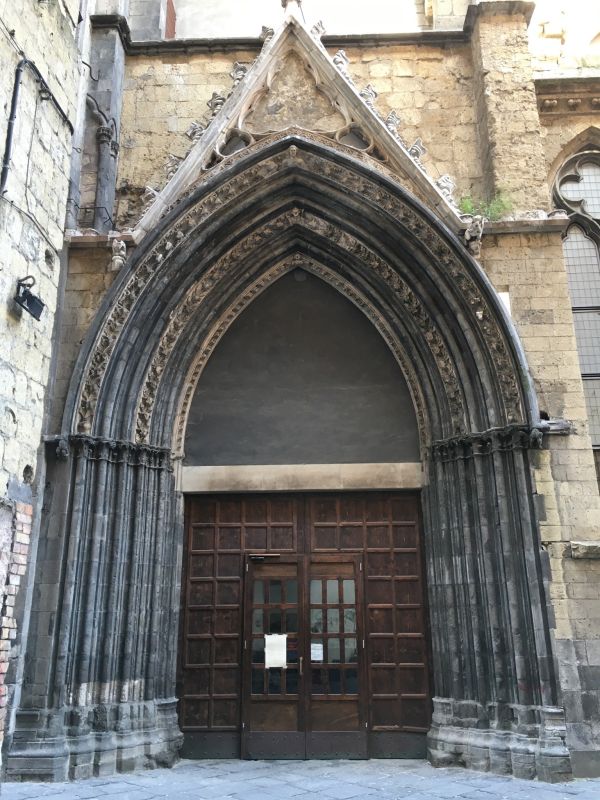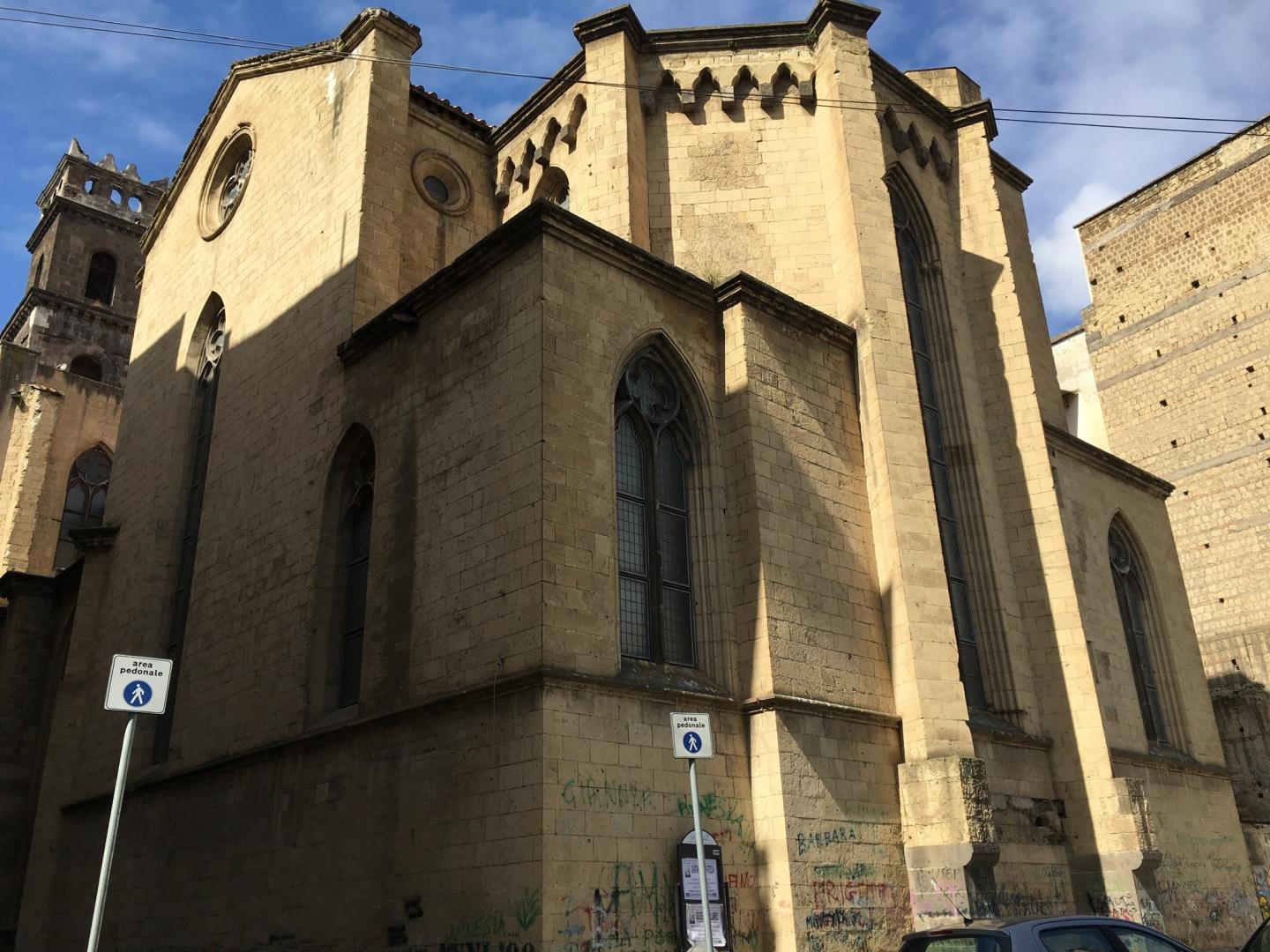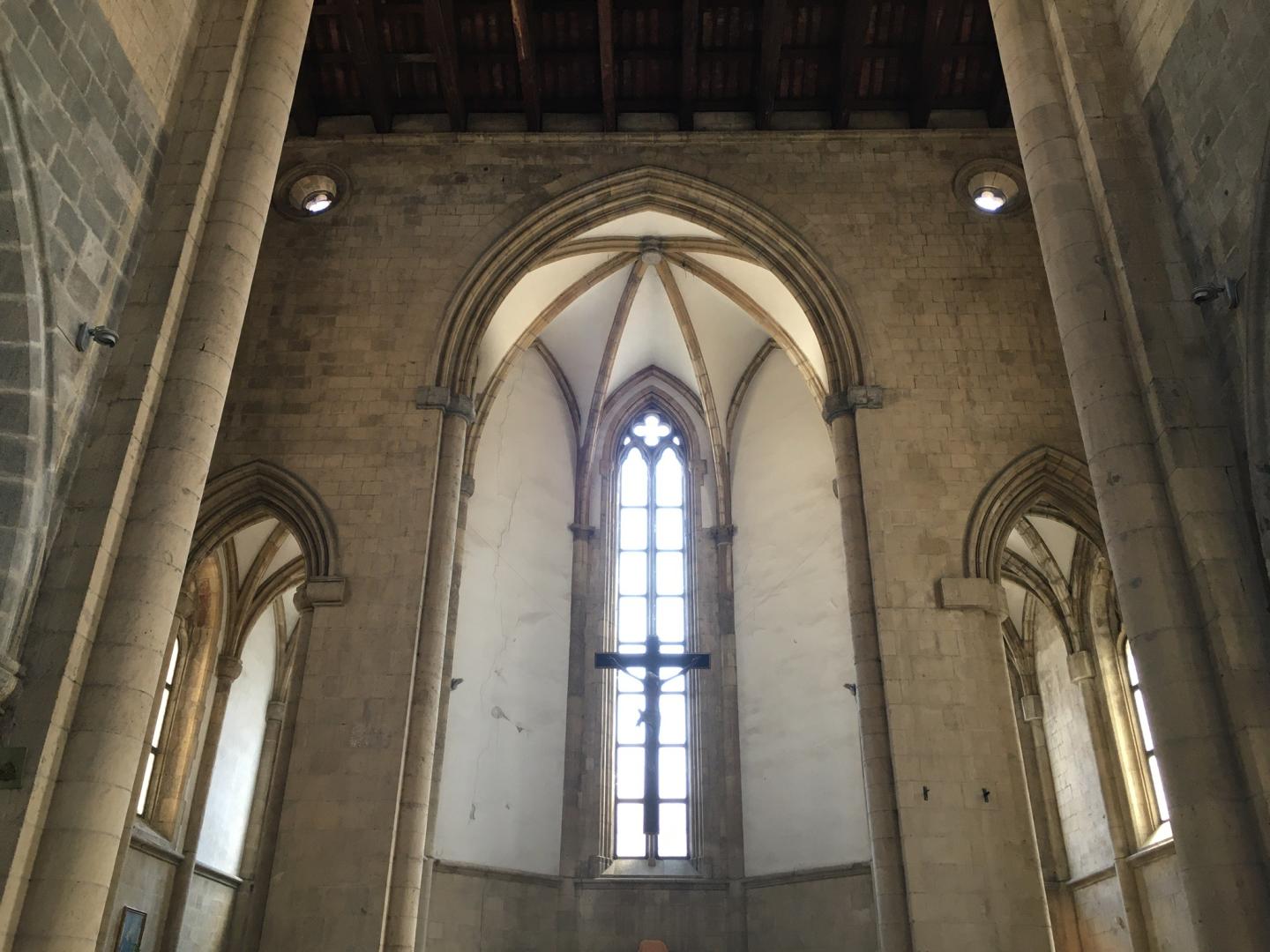One of the main buildings of Naples from the Angevin period is undoubtedly the church of Sant'EligioMaggiore, which is located a stone's throw from Piazza Mercato.
 It was founded, together with a hospital, by Giovanni Dottun, William of Burgundy and Giovanni de Lions, three Frenchmen belonging to the court of King Charles I of Anjou. In 1270, these obtained land in Campo Moricino and established a brotherhood dedicated to Saints Dionigi, Martino and Eligio with the aim of hosting the indigent and the sick in the hospital. Under the Angevins, the city of Naples experienced a very flourishing period, which led to a renewal of both urban structures and religious factories. Then, in 1546, Don Pedro of Toledo had the hospital completely rebuilt and founded a girls' boarding school, called the Conservatory for Virgins, where the girls studied medicine in order to provide nursing services at the adjoining hospital. In more recent times, the entire complex was hit by a bombing in March 1943 during the Second World War and, only afterwards, it was decided to opt for a restoration that would bring the church back to its original Gothic form, freeing it from the stuccos and alterations placed over the centuries.
It was founded, together with a hospital, by Giovanni Dottun, William of Burgundy and Giovanni de Lions, three Frenchmen belonging to the court of King Charles I of Anjou. In 1270, these obtained land in Campo Moricino and established a brotherhood dedicated to Saints Dionigi, Martino and Eligio with the aim of hosting the indigent and the sick in the hospital. Under the Angevins, the city of Naples experienced a very flourishing period, which led to a renewal of both urban structures and religious factories. Then, in 1546, Don Pedro of Toledo had the hospital completely rebuilt and founded a girls' boarding school, called the Conservatory for Virgins, where the girls studied medicine in order to provide nursing services at the adjoining hospital. In more recent times, the entire complex was hit by a bombing in March 1943 during the Second World War and, only afterwards, it was decided to opt for a restoration that would bring the church back to its original Gothic form, freeing it from the stuccos and alterations placed over the centuries.
The church of Sant'Eligio Maggiore, built mainly in yellow tuff and piperno, represents a formidable example of Gothic architecture in Naples. The Gothic movement, as we understand it today, was born in France in the Ile-de-France region and had a great development between the 11th and 14th centuries, especially in northern Europe. In Italy, however, Gothic did not have the same diffusion, since it had a difficult assimilation by the Italian masters of the time, who, while adhering to the new style, maintained their tradition aimed at the classical world. The church of Sant'Eligio Maggiore is a happy exception, as can be seen from its upward-facing shapes and the pointed arches that characterize the interior of the building. The true masterpiece of the church, however, is the original splayed portal, located on the right side. Today you enter from here, given that the main facade has been swallowed up by the adjacent buildings, following urban stratifications. This wonderful piperno portal is characterized by a pointed arch and ends with a spire crowned by a pinnacle.
Once you enter the church, you are immediately captivated by the austerity of the environments. The building has three naves, as well as a fourth dating back to the end of the 16th century. The central nave and the transept have a wooden trussed roof, while the side naves and the apse have a ribbed vaulted roof in yellow tuff with piperno members. The fourth chapel we were talking about was part of the ancient hospital and in it you can admire 14th century frescoes by various authors, including the Master of the Leonessa Chapel in San Pietro a Maiella. The church, however, still retains the chapels dedicated to the orders and trades that contributed over the centuries to the creation and renovation of the rooms. The most famous is undoubtedly the chapel of the Butchers of the Market with the marble frame created in 1509 by the Malvito workshop, very active in the city during the sixteenth century. The Sarti chapel, dedicated to Sant'Angelo, also features interesting frescoes from 1531, the work of the painters Giovan Paolo de Lupo and Giovanni Antonio Endece. On the west side of the church, you can admire a pillar on which there is a painting dated to the end of the 14th century and almost entirely preserved. The work depicts Pope Urban V holding the heads of Peter and Paul in his hands, a characteristic symbol of his iconography.
The church of Sant'Eligio Maggiore was once rich in works of art, many of which have now been put into museums or moved elsewhere. Among many, we think of the Last Judgment by the Flemish painter Cornelius Smet (1578). The panel, now preserved in the Capodimonte Museum, was originally located in the large chapel of the cruise. It seems that our painter was inspired by Michelangelo's famous Last Judgment in the Sistine Chapel. At one time, then, near the chapel dedicated to San Mauro, there was a Madonna della Misericordia by Francesco Solimena, which today is preserved in the institute annexed to the church.
Outside the building, the arch of Sant'Eligio (15th century) stands out on the road, connecting the bell tower of the church of the same name with the Angevin-era hospital. Despite the restorations that have taken place over the centuries, the arch has maintained its two-storey structure. The first floor, in Gothic style, houses the clock and two human heads representing a young woman and Duke Antonello Caracciolo, protagonists of a legend which we will talk about shortly. The second floor, however, houses a window with Aragonese coats of arms, behind which the condemned awaited the moment of their execution.
The legend of the girl and Antonello Caracciolo was also narrated by Benedetto Croce in "Neapolitan stories and legends". It is said that Caracciolo, an unscrupulous nobleman, fell in love with a young woman named Irene Malarba. Faced with the latter's reluctance, the man unjustly had her father convicted of murder. Caracciolo said that he would only release the unfortunate man if Irene satisfied his desires. This happened and Irene Malarba's father was freed. Following these events, from Calabria, the young woman's family came to Naples to invoke justice and obtained the favor of Isabella of Trastàmara, daughter of the sovereign Ferdinand II of Aragon. The queen, once the facts had been ascertained, had Caracciolo imprisoned and forced him to marry Irene Malarba in order to provide her with a large dowry. The man was beheaded in Piazza Mercato for the atrocities he had committed. Shortly before his execution, the young Irene, who had been forced to accompany him to the gallows, had suddenly fallen, also finding her death.




Comments powered by CComment